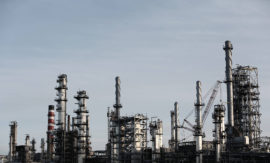Intended learning outcomes: Explain the formalized process train with stages and basic manufacturing steps. Identify the recipe.
Continuation from previous subsection (8.2.2).
Figure 8.2.2.2 represents the process train concept in a formalized way. This structure is the basic concept behind the data management of both master data objects and order objects in the process industries.
Fig. 8.2.2.2 Process train (formalized) with stages and basic manufacturing steps.
A process train is a representation of the flow of materials through a process industry manufacturing system that shows equipment and inventories ([APIC16]).
The term process unit stands for the (production) equipment that performs a basic manufacturing step, or operation, such as mixing or packaging.
Resources such as incoming and outgoing items, capacity, and production equipment are allocated to the basic manufacturing steps.
A process stage is a combination of (generally successive) process units.
In Figure 8.2.2.2, several (generally successive) stages are combined into process trains. Inventories in intermediate stores decouple the scheduling of sequential stages within a process train. However, if there is an intermediate product between two successive manufacturing steps of a stage, it is “only” a flow resource, which cannot nor should not be stored.
Processor-oriented production structure and production model are other terms used for process train.
Recipe or formula is the term commonly used to describe the content of a processor-oriented production structure[note 804].
A processor-oriented order structure is a processor-oriented production structure associated with a specific (production) order, in which quantities and dates are specified.
The process train thus defined can be regarded as an extension of the production structure underlying the process plan shown in Figure 1.2.3.3, but without showing the individual time periods that make up the lead time along the time axis.
As is every production structure, a process train may be the object of cost estimation. The corresponding processor-oriented order structure will then be the object of job-order costing. One special feature of such a calculation is that the costs incurred are distributed among the various resources produced, that is, primary and by-products. In the simplest case, this involves allocating a predetermined percentage to each resource produced by the production structure.
Exercise: Process train - formalized
Try to complete the empty boxes of the processor-oriented production structure.
Course section 8.2: Subsections and their intended learning outcomes

8.2 Processor-Oriented Master and Order Data Management
Intended learning outcomes: Produce an overview on processes, technology, and resources. Present the process train: a processor-oriented production structure. Disclose lot control in inventory management.

8.2.1 Processes, Technology, and Resources
Intended learning outcomes: Present processor-oriented master data and give examples of resources.

8.2.2 The Chocolate Production — An Example of a Processor-Oriented Production Structure
Intended learning outcomes: Describe the production structure in chocolate production. Explain the various manufacturing steps and stages in chocolate production.

8.2.2b The Process Train — A Formalized Processor-Oriented Production Structure, and The Recipe
Intended learning outcomes: Explain the formalized process train with stages and basic manufacturing steps. Identify the recipe.

8.2.3 Lot Control in Inventory Management
Intended learning outcomes: Describe the steps of lot control in inventory management. Identify the batch ID.
